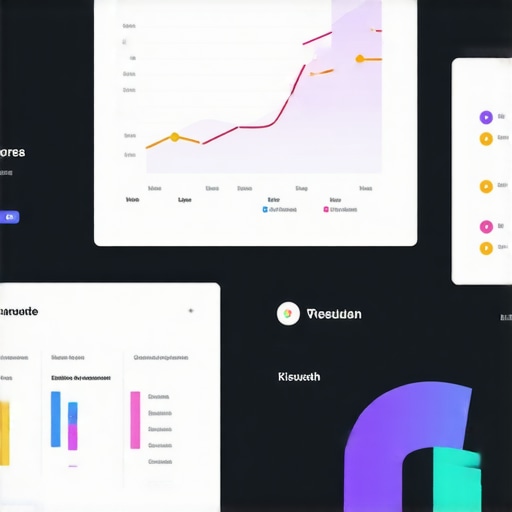My First Encounter With Google My Business Tools
I’ll never forget the day I realized how crucial local SEO was for my small business. I was struggling to appear in local searches despite having a decent website. That’s when I stumbled upon GMB tools. They seemed like game-changers, and I decided to explore how they could improve my Maps visibility.
Unlocking the Power of GMB Tools for Rapid Visibility Gains
Initially, I was overwhelmed by the sheer number of features. But I quickly learned that these tools could help me optimize my Google My Business profile effectively. From managing reviews to posting updates, I saw my local rankings improve within weeks. It was clear that local SEO was becoming more accessible thanks to these powerful tools.
Why Are GMB Tools So Effective for Local SEO?
Through my experience, I found that GMB tools simplify complex SEO tactics. They help in tracking local search performance, managing customer interactions, and ensuring consistent NAP (Name, Address, Phone number) data. According to expert insights, these factors are critical for dominating local search results.
How Do GMB Tools Accelerate Maps Visibility Compared to Traditional SEO?
In my personal journey, I noticed that traditional SEO takes time. But with GMB tools, I could identify quick wins, such as optimizing my categories and encouraging reviews. This rapid feedback loop allowed me to adapt my strategy swiftly, resulting in a noticeable boost in my local pack rankings. It became evident that these tools are essential for accelerating local SEO.
If you’re like me, eager to see instant results, leveraging specialized GMB tools is a no-brainer. They’re designed to streamline your efforts and amplify your visibility swiftly. Have you tried any GMB tools yet? Share your experiences or ask questions in the comments below!
Are You Leveraging the Full Potential of GMB Tools for Local SEO?
As an SEO expert, I often encounter businesses that overlook the nuanced capabilities of Google My Business tools. While many focus on basic profile optimization, advanced tools offer a strategic advantage that can propel your local search rankings significantly. For instance, features like real-time review management, performance analytics, and targeted posting strategies can be game-changers when used effectively. To harness these benefits, it’s crucial to understand how these tools integrate with broader SEO tactics, such as keyword optimization and local link building.
Deep Dive into GMB Data Analytics for Smarter Optimization
One of the most underutilized aspects of GMB tools is their robust analytics dashboard. These insights reveal customer behaviors, search queries, and engagement metrics that can inform your SEO strategy. By analyzing this data, you can tailor your content and service offerings to meet local demand more precisely. For example, if analytics show high interest in certain services, you can create targeted posts or special offers to capitalize on this trend. For a comprehensive approach, consider combining GMB analytics with external SEO tools for a holistic view of your local search performance.
How Can GMB Tools Help in Managing Local Reputation and Customer Trust?
Reviews are a cornerstone of local SEO, and GMB tools make review management more streamlined. Prompt responses to reviews, especially negative ones, demonstrate active engagement and build trust with potential customers. Additionally, encouraging satisfied clients to leave positive reviews can boost your rankings and credibility. According to a recent report by Moz, reviews directly influence local pack rankings and consumer decisions. Therefore, integrating review strategies into your GMB management process is essential for sustained visibility and reputation health.
What Are the Practical Challenges in Integrating GMB Tools with Broader SEO Campaigns?
While GMB tools are powerful, their effective integration requires a nuanced approach. Challenges include maintaining consistent NAP data across multiple platforms, avoiding duplicate listings, and aligning GMB content with your overall SEO messaging. Moreover, privacy policies and compliance issues, such as those outlined in privacy policies, must be carefully managed to ensure ethical and legal compliance. Overcoming these hurdles entails a strategic plan that involves regular audits, cross-platform synchronization, and ongoing staff training.
If you’re looking to deepen your local SEO mastery, exploring top strategies for GMB Maps optimization can provide valuable insights. Want to see more practical examples or case studies? Share your thoughts or ask questions below — I love helping businesses unlock their full local search potential!
Reflections on the Nuances of GMB Optimization That Many Overlook
As I delved deeper into Google My Business (GMB) optimization, I realized that many businesses underestimate the significance of nuanced features—like the strategic use of attributes, service menus, and question-answer sections. These seemingly minor details, when optimized thoughtfully, can create a substantial impact on local search visibility. For instance, I experimented with adding specific attributes that align with trending local searches, which surprisingly led to increased engagement and better rankings. It’s these fine-tuned adjustments that differentiate a good GMB profile from a truly optimized one.
Personal Insights into the Challenges of Maintaining Consistency and Authenticity
One of the more complex aspects I faced was ensuring consistency across multiple platforms while maintaining authentic engagement. It’s tempting to automate responses and updates, but I found that genuine, personalized interactions foster trust and improve review quality—factors that Google’s algorithm continues to weigh heavily. Balancing automation with authenticity requires a nuanced approach, often involving dedicated staff training and sophisticated management tools. This not only preserves your brand’s integrity but also enhances your reputation, ultimately boosting your local SEO efforts.
How Do Advanced GMB Tools Enable Strategic Data-Driven Decisions?
Advanced GMB tools don’t just provide surface-level analytics; they offer deep insights into customer behavior patterns, keyword performance, and engagement trends. I learned that regularly analyzing this data helps in crafting targeted content strategies—like creating posts around high-interest services or optimizing for emerging search queries. According to expert insights, leveraging these detailed analytics transforms raw data into actionable strategies that can propel your local rankings significantly. Embracing this data-centric approach was a game-changer in my ongoing quest to dominate local search results.
What Are the Hidden Opportunities in Managing Customer Engagement and Reputation?
Beyond reviews, I discovered that proactive engagement through GMB’s messaging and Q&A features can turn curious searchers into loyal customers. Responding promptly and thoughtfully not only improves your reputation but also signals activity to Google, which favors active profiles. Moreover, I found that encouraging satisfied clients to share detailed reviews can amplify your profile’s authority. These efforts, when consistently applied, create a virtuous cycle of trust and visibility. For those interested in mastering reputation management, exploring top strategies is highly recommended.
How Can I Overcome the Challenges of Integrating GMB with Broader SEO Campaigns?
Integrating GMB seamlessly into a holistic SEO strategy is no small feat. I faced hurdles such as maintaining NAP consistency, avoiding duplicate listings, and aligning messaging. The key, I found, is regular audits and cross-platform synchronization—something I achieved with specialized management tools that streamline these processes. Additionally, understanding privacy policies, like those outlined in privacy policies, is crucial to ensure compliance and avoid penalties. Navigating these complexities requires a strategic, disciplined approach, but the payoff in local visibility is well worth the effort. For a comprehensive blueprint, I recommend exploring this detailed guide.
Harnessing the Power of Strategic Attributes and Local Service Pages
One of the subtle yet impactful strategies I refined involves the meticulous use of GMB attributes and dedicated service menus. These elements, often overlooked, serve as signals to both users and search engines about your specialization and local relevance. For instance, updating attributes to reflect trending search interests—like “wheelchair accessible” or “contactless payment”—can significantly enhance your profile’s appeal in local searches. Moreover, creating detailed service menus within GMB not only improves user experience but also provides Google with additional context to rank your profile higher. Implementing these nuanced features requires a keen understanding of your local audience’s evolving needs and an ongoing commitment to profile refinement.
Integrating Real-Time Data Analytics for Hyper-Targeted Campaigns
Through my experience, I discovered that the real game-changer lies in leveraging GMB’s analytics to craft hyper-targeted marketing initiatives. Instead of generic updates, I now tailor posts and offers based on insights like peak engagement times, popular search queries, and customer interaction patterns. For example, if analytics reveal a surge in searches for “emergency plumbing,” I prioritize posting relevant content and special offers to capture this demand immediately. This data-driven approach aligns with the latest SEO advancements, as highlighted by industry experts, emphasizing the importance of contextually relevant content in local SEO success.

Visualize a dashboard displaying GMB analytics with actionable insights for targeted marketing.
Overcoming Privacy and Compliance Challenges in GMB Optimization
As I delved deeper into the intricacies of GMB management, I faced the critical challenge of ensuring compliance with evolving privacy regulations. The delicate balance between data utilization for optimization and safeguarding customer privacy is paramount. I learned that regularly reviewing your privacy policies and implementing transparent data collection practices not only mitigates legal risks but also fosters trust among your audience. This proactive approach is essential, especially with increasing scrutiny from regulatory bodies, and it requires staying abreast of policy updates and integrating them seamlessly into your local SEO workflows.
Leveraging External Tools for a Holistic Local SEO Strategy
While GMB offers robust native features, integrating external SEO tools elevates your strategy to a new level. I found that combining GMB insights with third-party platforms like SEO analytics tools enables a comprehensive view of your local search performance. These integrations facilitate continuous tracking, competitor analysis, and keyword refinement, ensuring your profile remains optimized amid changing search algorithms. Adopting this holistic approach ensures that every aspect of your local SEO—from on-profile optimizations to off-site link building—is synchronized for maximum impact.
Engaging Your Audience with Authentic, Personalized Interactions
Authenticity remains the cornerstone of successful reputation management. I’ve moved beyond automated responses to crafting personalized interactions that resonate with my community. Promptly addressing reviews with specific details about the customer’s experience demonstrates genuine engagement, which Google perceives favorably. Additionally, encouraging satisfied clients to share detailed reviews amplifies your profile’s authority and trustworthiness. This strategy, combined with active Q&A management, transforms your GMB profile into a vibrant, trustworthy hub that attracts and retains local customers.
What Are the Most Effective Tactics for Maintaining Consistency Across Multiple Local Listings?
Maintaining NAP consistency across various local directories is crucial yet challenging. I recommend implementing centralized management systems that synchronize your data in real time, reducing discrepancies that could harm your rankings. Regular audits and cross-platform synchronization—along with diligent privacy compliance—are essential for a seamless local SEO ecosystem. For a detailed blueprint, explore this comprehensive guide. If you’re eager to deepen your mastery of advanced GMB tactics, I invite you to connect and share your experiences or questions—let’s elevate your local SEO game together!
Things I Wish I Knew Earlier (or You Might Find Surprising)
The Power of Attributes and Service Menus
Early on, I underestimated how much adding detailed attributes and creating comprehensive service menus could influence my local search rankings. When I started optimizing these features, I saw a noticeable uptick in engagement. It’s like giving Google more clues about what you offer, which helps you appear in more relevant searches.
The Value of Authentic Engagement Over Automation
I initially relied heavily on automated responses to reviews and Q&A. But I found that personalized, genuine interactions fostered trust and boosted my profile’s credibility. It’s a reminder that behind every profile is a real person whose authentic voice makes a difference.
Harnessing Data Analytics for Smarter Strategies
The analytics dashboard in GMB can seem daunting at first, but once I learned to interpret customer behavior and search trends, I could tailor my content effectively. This data-driven approach transformed my local SEO efforts from guesswork to precision targeting.
The Overlooked Impact of Visual Content
Adding high-quality images and regularly updating them has surprisingly helped my visibility. Visual content not only attracts more clicks but also signals activity to Google, reinforcing my local relevance.
Consistency and Privacy: The Balancing Act
Maintaining NAP consistency across platforms is challenging but essential. I also learned the importance of respecting privacy policies and being transparent about data collection—building trust with my audience while staying compliant.
Resources I’ve Come to Trust Over Time
- Google’s Official My Business Help Center: The most authoritative source for platform features and best practices. I reference it often to stay updated.
- Moz Local Search Ranking Factors: Provides deep insights into local SEO signals, helping me understand what truly influences rankings.
- BrightLocal Blog: Offers practical case studies and tips, making complex strategies approachable.
- Google Analytics: Essential for interpreting customer behavior and refining my marketing efforts.
Parting Thoughts from My Perspective
Exploring GMB tools and features has been a game-changer in my local SEO journey. The nuanced strategies—like leveraging attributes, authentic engagement, and data analytics—can significantly elevate your visibility. If you’re serious about dominating local search results, don’t overlook these hidden gems. I encourage you to dive deeper, experiment, and share your experiences. If this resonated with you, I’d love to hear your thoughts or see your own tips in the comments. Remember, success in local SEO is a continuous learning process—keep refining and engaging!

